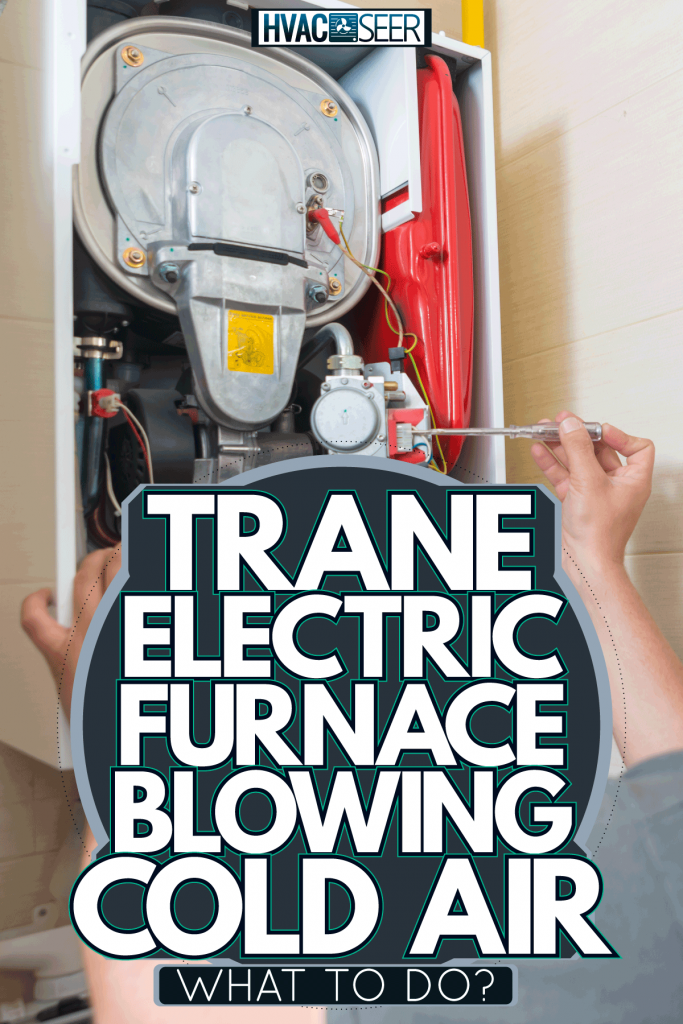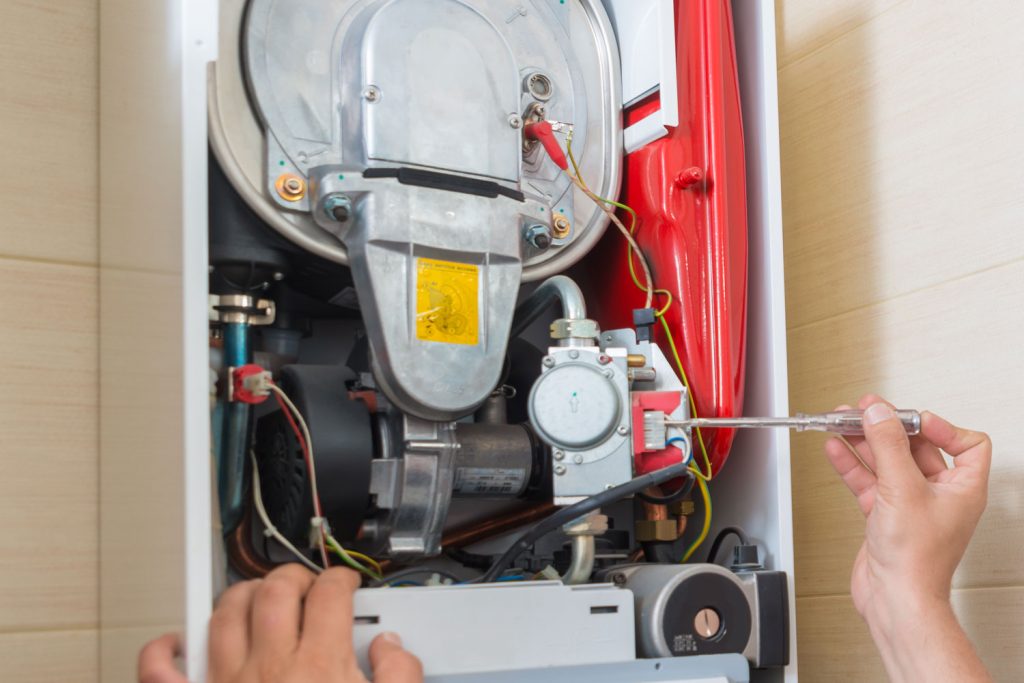Electric Trane furnaces have become increasingly popular in the residential home market. Unfortunately, just like other furnaces, these units can malfunction at some point. So what do you do if your electric Trane furnace starts blowing cold air? For your convenience, we have researched how to troubleshoot this issue.
If your electric Trane furnace is blowing cold air, here are the things that you should check:
- Test the heat sensor
- Check your ductwork
- Inspect the heat coil circuit
- Inspect the heating coils
- Test the coil contactor
- Clean the air filter
- Check the condensate line for clogs
- Double-check the thermostat
The good news is that the furnace may only be experiencing a simple issue, and you may be able to solve the problem all on your own. However, if you find that you can't resolve the issue, don't hesitate to reach out to an experienced HVAC technician for assistance. Continue reading to learn more about how to troubleshoot the problem.

Troubleshooting Your Trane Furnace
Test the heat sensor
Electronic furnaces have a heat sensor that ensures that the coils produce heat when the unit is turned on. When the thermostat reaches the desired heating point, the sensor shuts off the blower fan.
However, over time the sensor can become faulty, and it may not be able to signal to the blower fan that the unit needs to turn off. This will cause the furnace to continue running without creating any additional heat.
As a result, it will blow out cold air instead of warm air. The heat sensor is a relatively small part and is easy to access.
You can try to replace the sensor yourself, but it's best to have a technician take a look at it so they can inspect other related components as well (especially if your furnace is over ten years old).
If the sensor is broken or faulty, it will need to be replaced. Luckily, this is a fairly simple fix.
Check your ductwork
It's also a good idea to check your vent ducts. The furnace may be blowing warm air that's becoming cold because there are cracks and holes in your home's ductwork. Replacing or sealing the ducks can help to fix this issue.
An HVAC technician can take a look at your ductwork (and any surrounding insulation) and provide the best solution. If you need new installation order for ductwork, it's best to have it done sooner rather than later to prevent energy cost increases.
Inspect the heat coil circuit
Electric furnaces have an electric panel that contains heating elements; these elements control the unit's temperature. Sometimes the circuit that controls the heating element can become faulty or trip during a power outage.
The circuit will typically be labeled, and if it is turned off, switch it to the "On" position. If you suspect that the circuit has tripped, switch it to "Off" the opposition first, and then back to the "On" position to see if this fixes the issue.
Inspect the heating coils
Sometimes the coils in an electric furnace can burn out as well. This can happen over time due to normal wear and tear or after a power surge—which is the more common reason this will occur.
When a coil burns out, the furnace blower will continue to run. However, the unit will not produce hot air when this happens.
You will need to replace the coil to fix the issue. However, if your furnace is over seven years old, it may be best to replace all of the coils, as others will likely malfunction in the near future.
This can be a DIY job if you have experience working with electrical components and are familiar with the inner workings of a furnace. If not, it may be best to contract the work out to an HVAC professional.
Test the coil contactor
The contactor is a heavy-duty relay in electric furnaces that allows the coils to heat up. If the contactor is faulty, it will need to be removed and replaced with a new one. This is another fairly simple fix.
The contactor only has a couple of wires and is easy to access. You will need to ensure that the replacement contacts, however, have the same amps and voltage as the previous one.
Also, it's best to take a picture of the contactor's wiring before removing it to remember how to connect the new one.
Clean the air filter
A clogged air filter can cause a number of issues with your electric furnace. If the filter is covered with soot, grime, or dust, it will block incoming air from the furnace, causing it to overheat and cycle too long.
If this happens, the blower will eventually blow out cold air at some point. HVAC professionals recommend changing your air filter at least every one to two months to prevent the furnace from overheating and potentially malfunctioning.
This will also ensure that your home receives quality air from the unit and reduces the number of airborne contaminants that you're exposed to.
Check the condensate line for clogs
Similar to gas furnaces, electric furnaces also have condensate lines that provide an exit route for the unit's moisture and water.
Once the water is collected by the unit evaporator coil, it moves through the condensate line and into a condensate pan.
However, over time the line can become clogged with slime, dirt, and other debris. If this happens, the float switch can become tripped, which causes the blower fan to shut down.
The only solution to this issue is to simply clear the condenser line using a commercial vinegar or diluted bleach solution.
Double-check the thermostat
This may seem obvious, but it's always best to double-check the thermostat before assuming that the furnace is malfunctioning.
Sometimes the heater may be blowing cold air because the thermostat has been in the "On" setting continuously, which will cause the unit to run even when there is no heat being produced.
If you experience this issue often, you may want to consider using a pre-programmed or Auto setting to help prevent it in the future.
How do you reset an electric furnace?

Most electric furnaces have a reset button that will restart the unit if it begins to malfunction.
The reset button is typically located inside the furnace near the control panel. To access it, you will typically need to remove the front panel of the furnace.
Some models may have limit switches that perform system resets. It's best to refer to your user manual to determine how to reset the furnace.
And if all else fails, you can always reset the furnace by flipping the switch on your circuit breaker to the off position and back to the on position.
Does the Trane xe90 have a pilot light?
No, this furnace model does not have a pilot light. It has a hot surface ignitor instead.
Can I clean a Trane furnace filter?
Most Trane furnaces come with an air filter that is disposable and will need to be replaced once it becomes dirty.
However, Trane also makes the Trane CleanEffects Air Cleaner, an air filtration system that you can connect to your furnace. These air filters do not need to be replaced but can be cleaned using soap and water instead.
What size filter does a Trane furnace use?
The filter size that you need for your Trane furnace will depend on the model and configuration of the furnace. The width of the furnaces cabinet also plays a role in how big the filter is.
For example, some Trane furnaces use filters that are 17x25x1, while others may take larger filters such as 20x25x1. The filter size will be located in your user's manual.
Where is the air filter for a Trane xr95?
The air filter's location depends on where the airflow is in the furnace.
For example, if the furnace is an upflow unit, the filter will typically be located on the bottom of the furnace. And if the unit is an upflow horizontal model, it will be located in a remote location.
Wrapping Things Up
We hope this post has helped illustrate the best steps to take when your electric Trane furnace blows cold air.
Remember that troubleshooting a malfunctioning furnace may take a bit of time, but it's definitely worth the effort if you're able to save money and repair costs.
And, of course, if you find that you are venturing outside of your wheelhouse, it's best to seek the assistance of an experienced HVAC technician.
Before you go, be sure to check out our other posts:
How To Insulate A Bonus Room Above The Garage – 4 Methods To Try
How To Convert An Oil Furnace To Gas Or Propane—And Should You?
